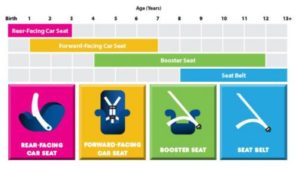
The world of transporting a child has become more complicated. Believe me—I know. We have three kids in three different types of car seats! Using the right car seat can make the difference between life and death—so we want to make your little one is traveling safely.
The five types of car seats
Graphic courtesy of safercar.gov – click to see details
Infant carrier
For newborns and small babies. This is portable seat and only rear-facing. Babies typically grow out of it between eight and nine months.
Convertible
This seat changes from rear to forward facing as the child grows. It holds the child with a five-point harness. This and the all-in-one have higher height and weight limits than the infant carrier for rear-facing.
All-in-One
This seat changes from rear to forward facing and then to booster seat. It has a five-point-harness for the younger years.
Combination
This seat can only face forward, but will transition from a five-point harness seat into a booster.
Booster
These seats boost the child so the seatbelt fits properly. There are high back and backless boosters. The high-back booster provides extra head and neck support in vehicles with no head rests.
Choosing the right car seat based on age
Birth to 12 months
A child under one should always ride in a rear-facing seat.
1 to 3 years
Keep the child rear-facing as long as possible and as long as he is under the top height or weight limit allowed by the car seat manufacturer. Once the child outgrows the rear-facing seat, they can be forward-facing.
4 to 7 years
Keep the child in a car seat with a five-point harness until he reaches the top height or weight limit allowed by the seat.
8 to 12 years
Keep the child in a booster until a seatbelt fits properly. The lap belt must fit snuggly across the upper thighs, not the stomach. The shoulder belt must fit snuggly across the shoulder and chest, not the neck or face. ALWAYS put children in the back seat.
For more car seat tips, visit www.safercar.gov.
Considering A Second-Hand Car Seat?
If you are considering using a second-hand car seat, use the checklist below. If you can check off each one of these statements, then the second-hand seat may be okay to use.
- The seat has never been involved in a moderate to severe crash.
- The seat has labels stating date of manufacture and model number. You need this information to find out if there is a recall on the car seat or if the seat is too old.
- The seat has no recalls. If you do find a recall on the car seat, you should contact the manufacturer as some problems can be fixed.
- The seat has all its parts. If the seat is missing a part, contact the manufacturer as some parts can be ordered.
- The seat has its instruction book. You can also order the instruction manual from the manufacturer.



